Numerical Simulation and Experimental Validation of Thermal Break Strips’ Improvement in Facade LSF Walls
Abstract
1. Introduction
2. Methods and Materials
2.1. Characterization of the LSF Facade Walls
2.1.1. Reference Facade LSF Wall
2.1.2. Thermal Break Strips
2.2. Experimental Lab Tests
2.2.1. Experimental Setup
2.2.2. Set-Points and Test Procedures
2.2.3. Experimental Procedures’ Verification
2.3. Numerical Simulations
3. Results
3.1. Measured and Predicted R-Values
3.2. Measured Thermal Resistance Improvement
3.3. Infrared Thermography Assessment
4. Discussion of Results
5. Conclusions
- The outer and inner TB strips still have very similar thermal performances. However, as happened before for partition walls, the TB strips positioned in the outer steel flange of the facade LSF walls appear to have slightly better performance (around +1% in the measured R-value).
- Again, as expected, the best performances were found for double TB strips and for aerogel TB strips.
- However, neither the former load-bearing partition LSF wall, neither this new facade LSF wall, were able to fully mitigate the steel frame thermal bridges’ effect, not even for the best thermal performance configuration (two aerogel TB strips).
- Quite similar thermal performances were measured for the other two materials: recycled rubber (R1), and rubber/cork composite (R0).
- Comparing the thermal resistance improvement for these facade LSF walls and the previously assessed partition LSF walls, it was observed that the TB strips were clearly less efficient in facade LSF walls.
Author Contributions
Funding

Acknowledgments
Conflicts of Interest
References
- Farouk, N.; El-Rahman, M.A.; Sharifpur, M.; Guo, W. Assessment of CO2 emissions associated with HVAC system in buildings equipped with phase change materials. J. Build. Eng. 2022, 51, 104236. [Google Scholar] [CrossRef]
- European Union. Directive (EU) 2018/844 of the European Parliament and of the Council of 30 May 2018 amending Directive 2010/31/EU on the energy performance of buildings and Directive 2012/27/EU on energy efficiency. Off. J. Eur. Union 2018, 2018, 75–91. [Google Scholar]
- D’Agostino, D.; Tzeiranaki, S.T.; Zangheri, P.; Bertoldi, P. Assessing Nearly Zero Energy Buildings (NZEBs) development in Europe. Energy Strateg. Rev. 2021, 36, 100680. [Google Scholar] [CrossRef]
- Bustos García, A. Morteros con Propiedades Mejoradas de Ductilidad por Adición de Fibras de Vidrio, Carbono y Basalto. Doctoral Thesis, Universidad Politécnica de Madrid, Madrid, Spain, 2018. (In Spanish). [Google Scholar]
- European Commission. The European Green Deal. In Communication from the European Comission: COM/2019/640 Final, 11.12.2019; EUR-Lex: Brussels, Belgium, 2019. [Google Scholar]
- Cutanda, B.L.; Turrillas, J.C.A. Administración y Legislación Ambiental, 11th ed.; Dykinson: Madrid, Spain, 2020; ISBN 978-84-1324-302-3. [Google Scholar]
- Buckley, N.; Mills, G.; Reinhart, C.; Berzolla, Z.M. Using urban building energy modelling (UBEM) to support the new European Union’s Green Deal: Case study of Dublin Ireland. Energy Build. 2021, 247, 111115. [Google Scholar] [CrossRef]
- Rezai, S.H.; Allard, F.; Abelé, C.; Doya, M. Evaluating External Thermal Insulation Composite Systems (ETICS) regarding the building’s global performance. Energy Procedia 2015, 78, 1562–1567. [Google Scholar] [CrossRef]
- Parracha, J.; Borsoi, G.; Flores-Colen, I.; Veiga, R.; Nunes, L.; Dionísio, A.; Gomes, M.G.; Faria, P. Performance parameters of ETICS: Correlating water resistance, bio-susceptibility and surface properties. Constr. Build. Mater. 2021, 272, 121956. [Google Scholar] [CrossRef]
- Fernandes, C.; de Brito, J.; Cruz, C.O. Architectural integration of ETICS in building rehabilitation. J. Build. Eng. 2016, 5, 178–184. [Google Scholar] [CrossRef]
- Luján, S.V.; Arrebola, C.V.; Sánchez, A.R.; Benito, P.A.; Cortina, M.G. Experimental comparative study of the thermal performance of the façade of a building refurbished using ETICS, and quantification of improvements. Sustain. Cities Soc. 2019, 51, 101713. [Google Scholar] [CrossRef]
- Kolaitis, D.I.; Malliotakis, E.; Kontogeorgos, D.A.; Mandilaras, I.; Katsourinis, D.I.; Founti, M.A. Comparative assessment of internal and external thermal insulation systems for energy efficient retrofitting of residential buildings. Energy Build. 2013, 64, 123–131. [Google Scholar] [CrossRef]
- Santos, P.; da Silva, L.S.; Ungureanu, V. Energy Efficiency of Light-Weight Steel-Framed Buildings, 1st ed.; Technical Committee 14—Sustainability & Eco-Efficiency of Steel Construction; European Convention for Constructional Steelwork (ECCS): Brussels, Belgium, 2012; ISBN 978-92-9147-105-8. [Google Scholar]
- Choi, J.-S.; Kim, C.-M.; Jang, H.-I.; Kim, E.-J. Detailed and fast calculation of wall surface temperatures near thermal bridge area. Case Stud. Therm. Eng. 2021, 25, 100936. [Google Scholar] [CrossRef]
- Liu, C.; Mao, X.; He, L.; Chen, X.; Yang, Y.; Yuan, J. A new demountable light-gauge steel framed wall: Flexural behavior, thermal performance and life cycle assessment. J. Build. Eng. 2022, 47, 103856. [Google Scholar] [CrossRef]
- Perera, D.; Poologanathan, K.; Gillie, M.; Gatheeshgar, P.; Sherlock, P.; Upasiri, I.; Rajanayagam, H. Novel conventional and modular LSF wall panels with improved fire performance. J. Build. Eng. 2022, 46, 103612. [Google Scholar] [CrossRef]
- Alembagheri, M.; Sharafi, P.; Rashidi, M.; Bigdeli, A.; Farajian, M. Natural dynamic characteristics of volumetric steel modules with gypsum sheathed LSF walls: Experimental study. Structures 2021, 33, 272–282. [Google Scholar] [CrossRef]
- Tavares, V.; Soares, N.; Raposo, N.; Marques, P.; Freire, F. Prefabricated versus conventional construction: Comparing life-cycle impacts of alternative structural materials. J. Build. Eng. 2021, 41, 102705. [Google Scholar] [CrossRef]
- Perera, D.; Upasiri, I.; Poologanathan, K.; Gatheeshgar, P.; Sherlock, P.; Hewavitharana, T.; Suntharalingam, T. Energy performance of fire rated LSF walls under UK climate conditions. J. Build. Eng. 2021, 44, 103293. [Google Scholar] [CrossRef]
- Moga, L.; Petran, I.; Santos, P.; Ungureanu, V. Thermo-Energy Performance of Lightweight Steel Framed Constructions: A Case Study. Buildings 2022, 12, 321. [Google Scholar] [CrossRef]
- Santos, P.; Gonçalves, M.; Martins, C.; Soares, N.; Costa, J.J. Thermal Transmittance of Lightweight Steel Framed Walls: Experimental versus Numerical and Analytical Approaches. J. Build. Eng. 2019, 25, 100776. [Google Scholar] [CrossRef]
- Santos, P.; Lemes, G.; Mateus, D. Analytical Methods to Estimate the Thermal Transmittance of LSF Walls: Calculation Procedures Review and Accuracy Comparison. Energies 2020, 13, 840. [Google Scholar] [CrossRef]
- Santos, P.; Poologanathan, K. The Importance of Stud Flanges Size and Shape on the Thermal Performance of Lightweight Steel Framed Walls. Sustainability 2021, 13, 3970. [Google Scholar] [CrossRef]
- Roque, E.; Santos, P. The Effectiveness of Thermal Insulation in Lightweight Steel-Framed Walls with Respect to Its Position. Buildings 2017, 7, 13. [Google Scholar] [CrossRef]
- Roque, E.; Santos, P.; Pereira, A.C. Thermal and sound insulation of lightweight steel-framed façade walls. Sci. Technol. Built Environ. 2019, 25, 156–176. [Google Scholar] [CrossRef]
- Santos, P.; Ribeiro, T. Thermal Performance of Double-Pane Lightweight Steel Framed Walls with and without a Reflective Foil. Buildings 2021, 11, 301. [Google Scholar] [CrossRef]
- Santos, P.; Ribeiro, T. Thermal Performance Improvement of Double-Pane Lightweight Steel Framed Walls Using Thermal Break Strips and Reflective Foils. Energies 2021, 14, 6927. [Google Scholar] [CrossRef]
- Santos, P.; Abrantes, D.; Lopes, P.; Mateus, D. Experimental and Numerical Performance Evaluation of Bio-Based and Recycled Thermal Break Strips in LSF Partition Walls. Buildings 2022, 12, 1237. [Google Scholar] [CrossRef]
- Martins, C.; Santos, P.; da Silva, L.S. Lightweight steel-framed thermal bridges mitigation strategies: A parametric study. J. Build. Phys. 2016, 39, 342–372. [Google Scholar] [CrossRef]
- Santos, P.; Mateus, D. Experimental assessment of thermal break strips performance in load-bearing and non-load-bearing LSF walls. J. Build. Eng. 2020, 32, 101693. [Google Scholar] [CrossRef]
- WEBERTHERM UNO. Technical Sheet: Weber Saint-Gobain ETICS Finish Mortar. 2018. Available online: www.pt.weber/files/pt/2019-04/FichaTecnica_weberthermuno.pdf (accessed on 14 March 2019). (In Portuguese).
- TincoTerm. Technical Sheet: EPS 100. 2015. Available online: http://www.lnec.pt/fotos/editor2/tincoterm-eps-sistema-co-1.pdf (accessed on 14 March 2021). (In Portuguese).
- Santos, P.; Lemes, G.; Mateus, D. Thermal Transmittance of Internal Partition and External Facade LSF Walls: A Parametric Study. Energies 2019, 12, 2671. [Google Scholar] [CrossRef]
- Santos, C.; Matias, L. ITE50—Coeficientes de Transmissão Térmica de Elementos da Envolvente dos Edifícios; LNEC—Laboratório Nacional de Engenharia Civil: Lisbon, Portugal, 2006. (In Portuguese) [Google Scholar]
- MS-R0 Test Report. Test Report Ref. 5015 PE 1977/08—Determination of Thermal Conductivity (Acousticork MS-R0); Departamento de Engenharia Têxtil, Universidade do Minho: Braga, Portugal, 2008.
- ISO 9869-1; Thermal Insulation—Building Elements—In-Situ Measurement of Thermal Resistance and Thermal Transmittance. Part 1: Heat Flow Meter Method. ISO—International Organization for Standardization: Geneva, Switzerland, 2014.
- Soares, N.; Martins, C.; Gonçalves, M.; Santos, P.; da Silva, L.S.; Costa, J.J. Laboratory and in-situ non-destructive methods to evaluate the thermal transmittance and behaviour of walls, windows, and construction elements with innovative materials: A review. Energy Build. 2019, 182, 88–110. [Google Scholar] [CrossRef]
- Rasooli, A.; Itard, L. In-situ characterization of walls’ thermal resistance: An extension to the ISO 9869 standard method. Energy Build. 2018, 179, 374–383. [Google Scholar] [CrossRef]
- ASTM-C1155–95 (Reapproved-2013); Standard Practice for Determining Thermal Resistance of Building Envelope Components from the In-Situ Data. ASTM—American Society for Testing and Materials: Philadelphia, PA, USA, 2013.
- ASTM-C1046–95 (Reapproved-2013); Standard Practice for In-Situ Measurement of Heat Flux and Temperature on Building Envelope Components. ASTM—American Society for Testing and Materials: Philadelphia, PA, USA, 2013.
- ASHRAE. Handbook of Fundamentals (SI Edition); ASHRAE—American Society of Heating, Refrigerating and Air-conditioning Engineers: Atlanta, GA, USA, 2017. [Google Scholar]
- ISO 6946; Building Components and Building Elements—Thermal Resistance and Thermal Transmittance—Calculation Methods. International Organization for Standardization: Geneva, Switzerland, 2017.
- ISO 10211; Thermal Bridges in Building Construction—Heat Flows and Surface Temperatures—Detailed Calculations. ISO—International Organization for Standardization: Geneva, Switzerland, 2017.
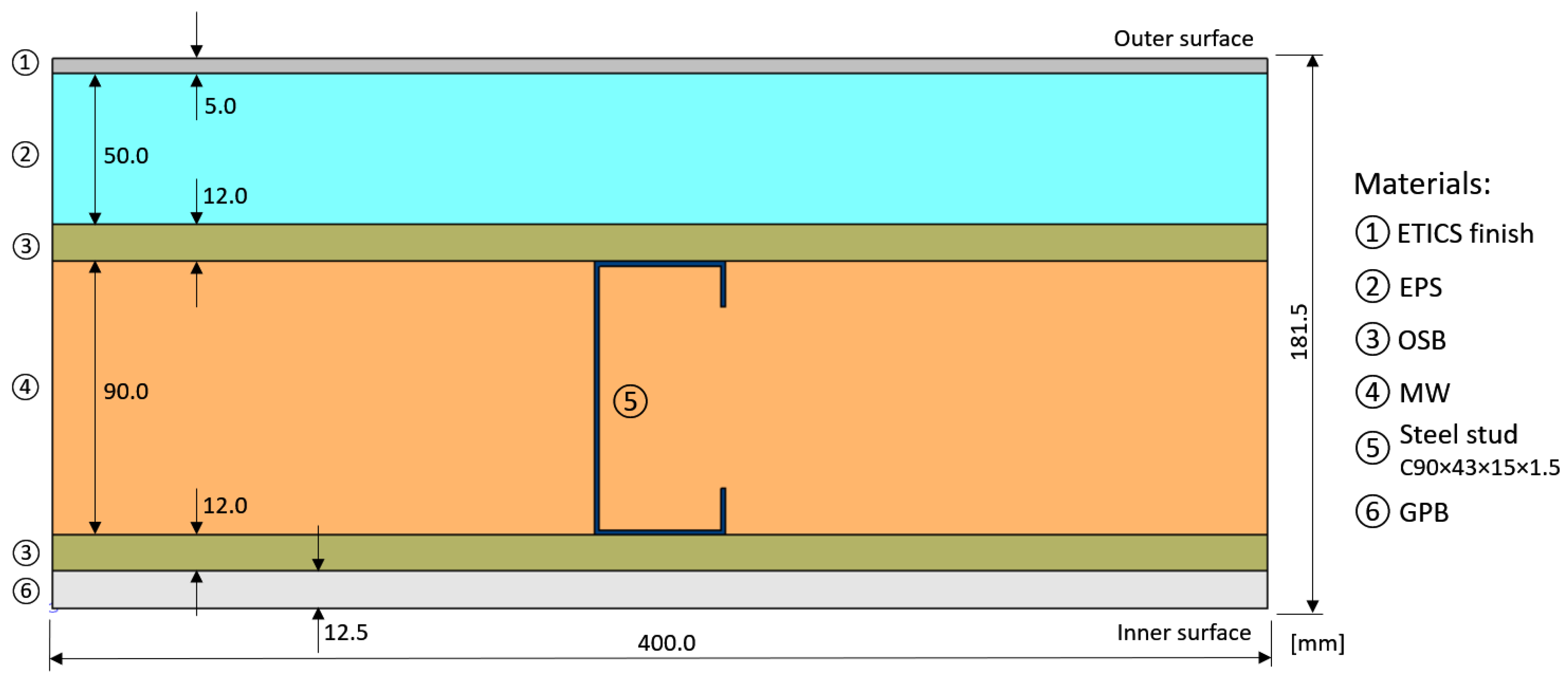
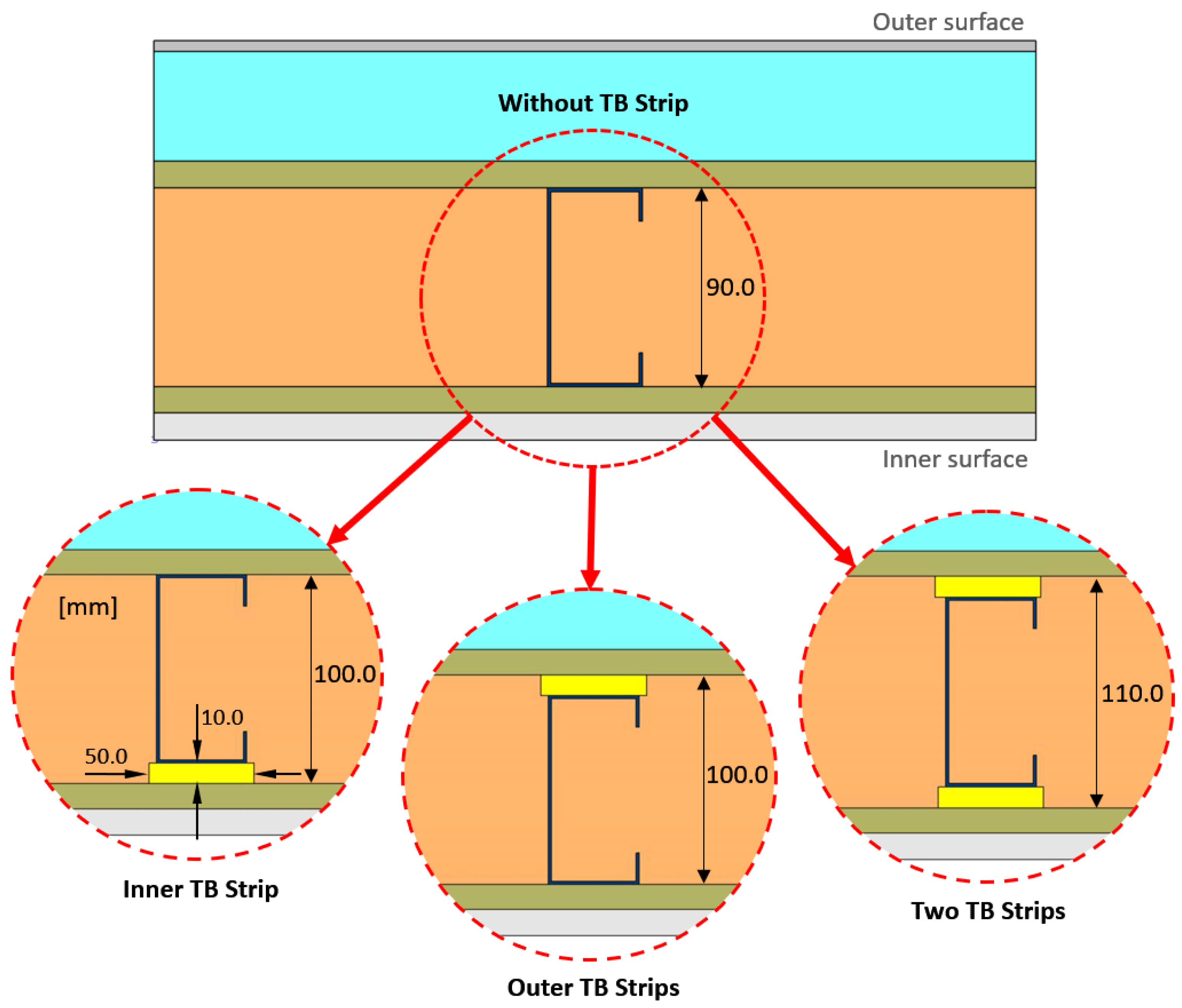
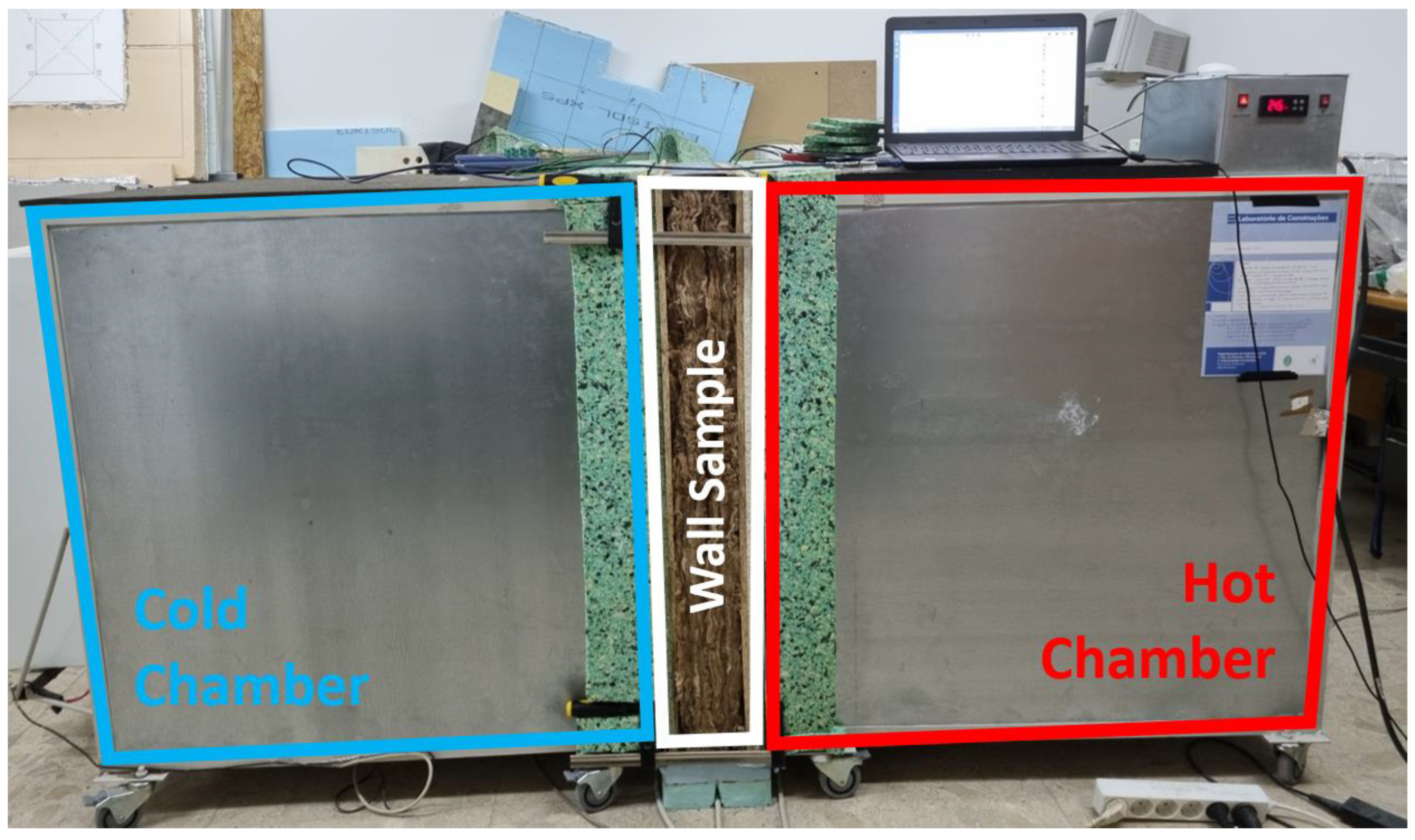
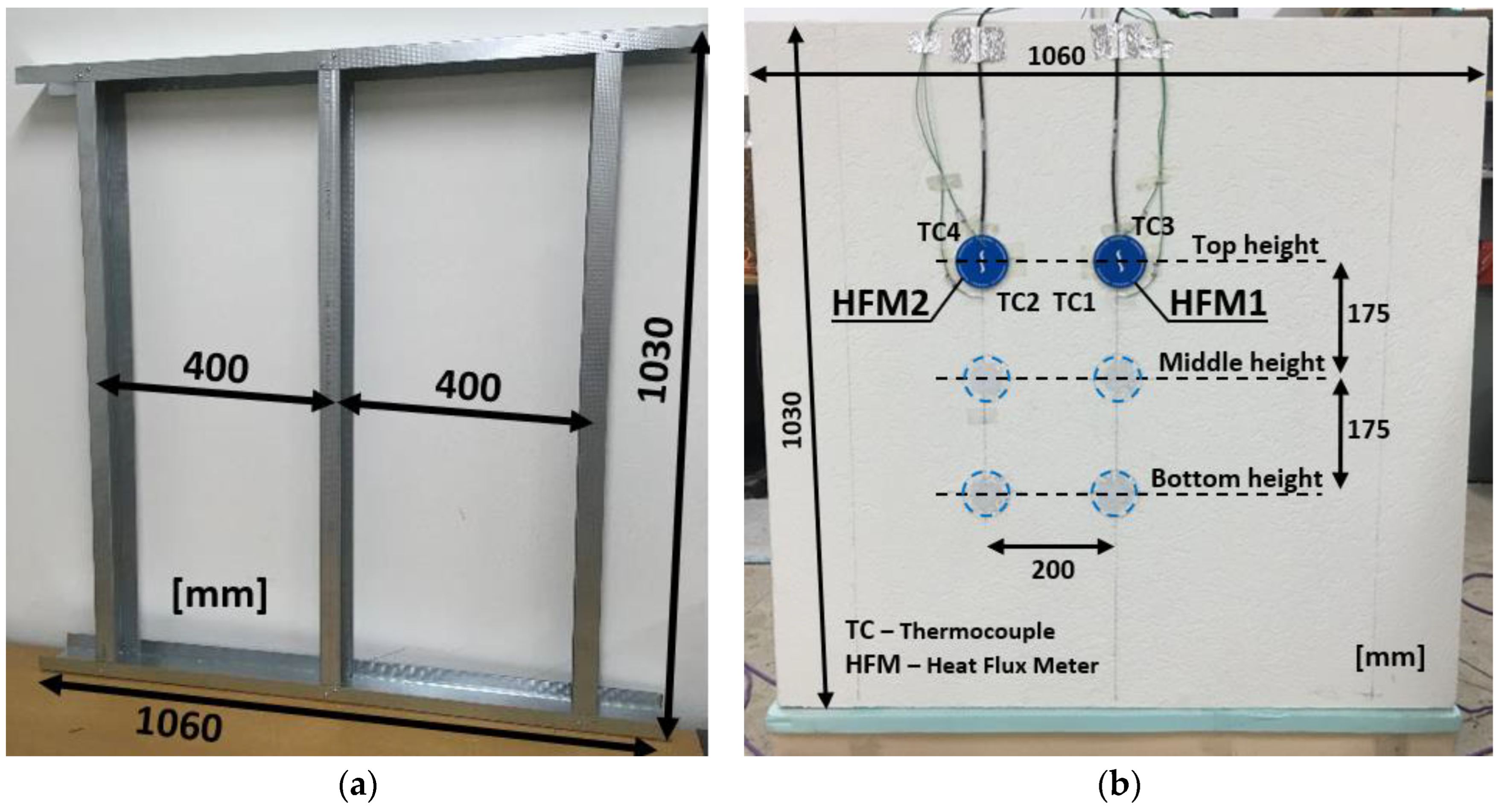

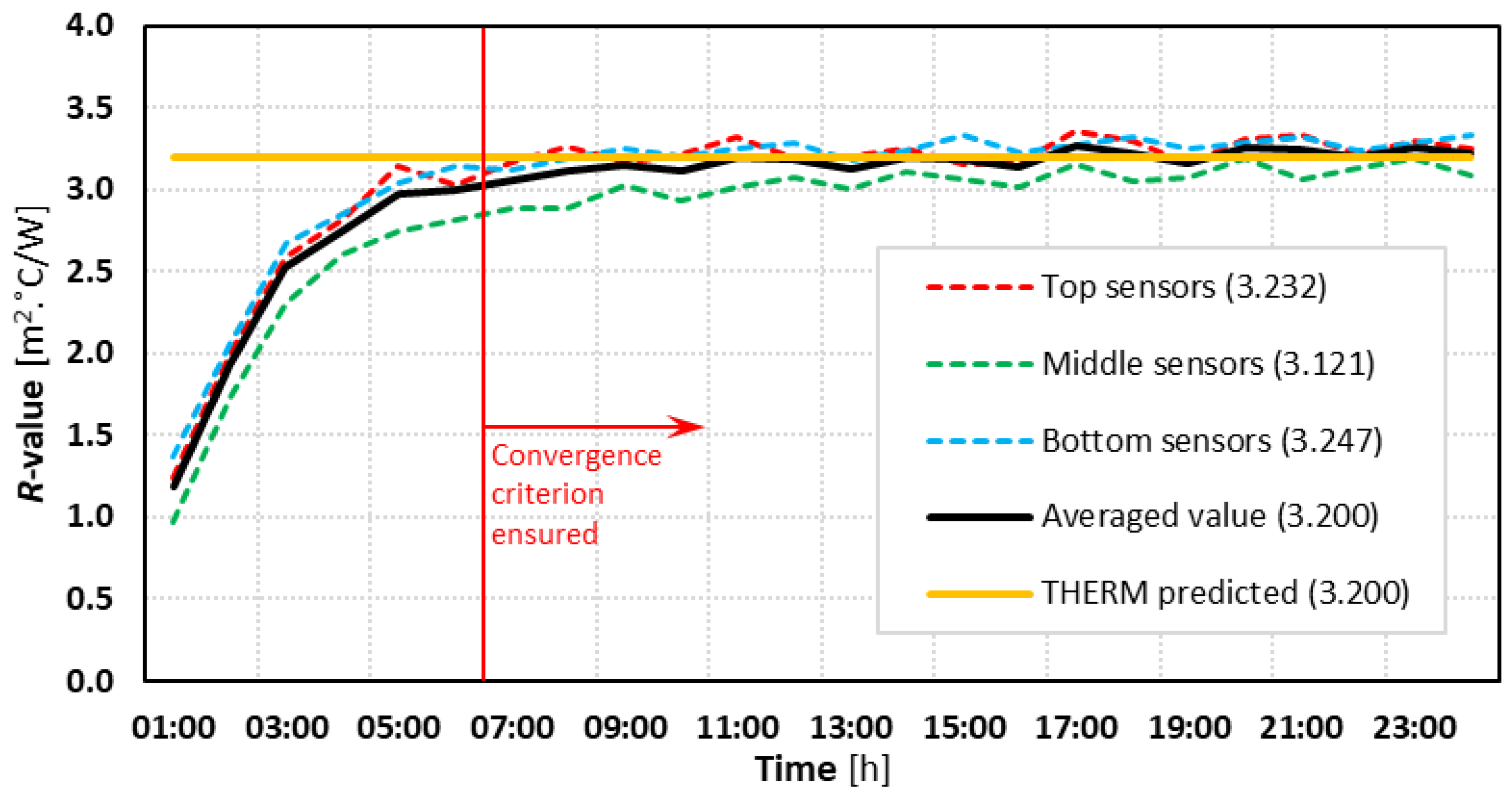


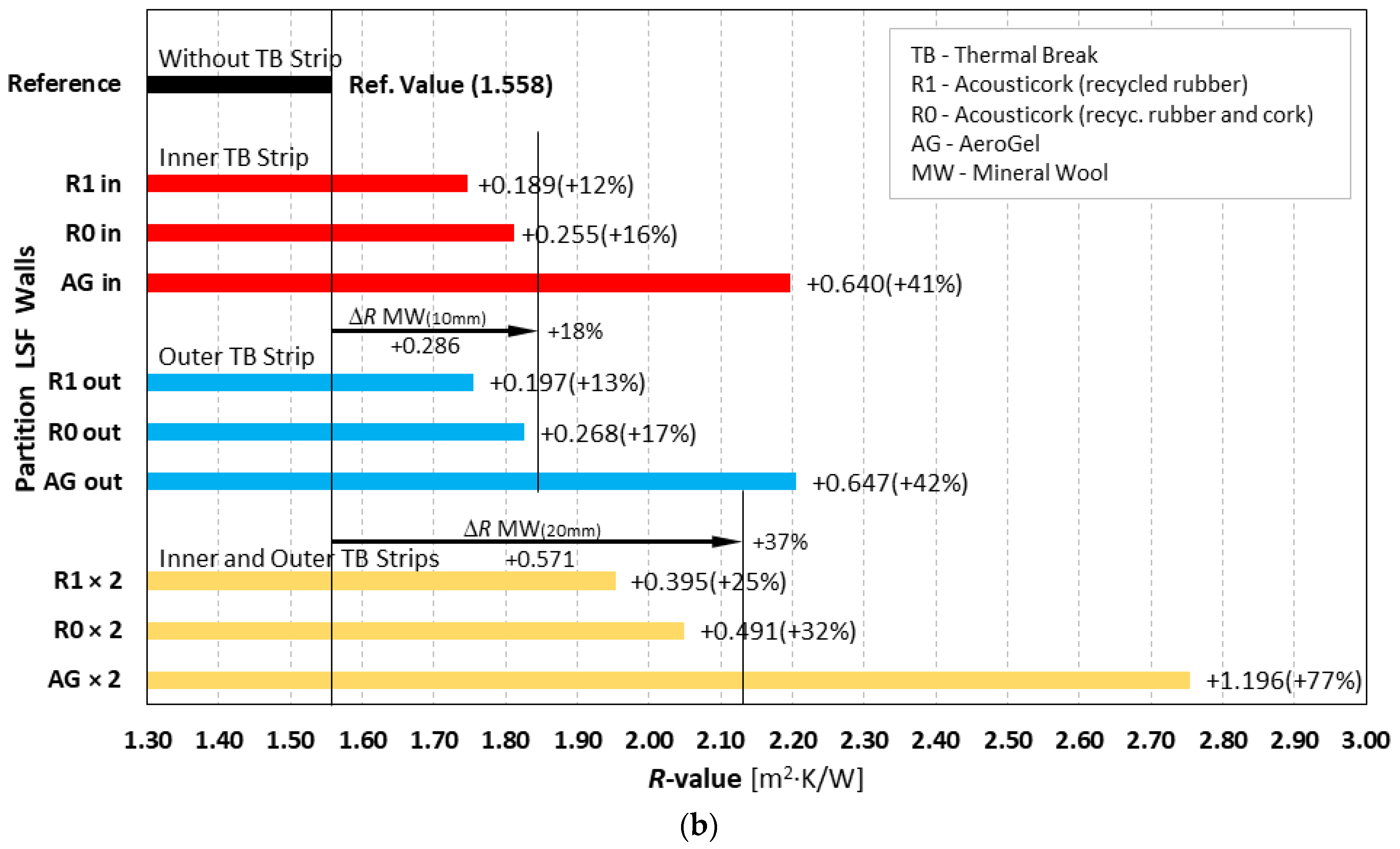
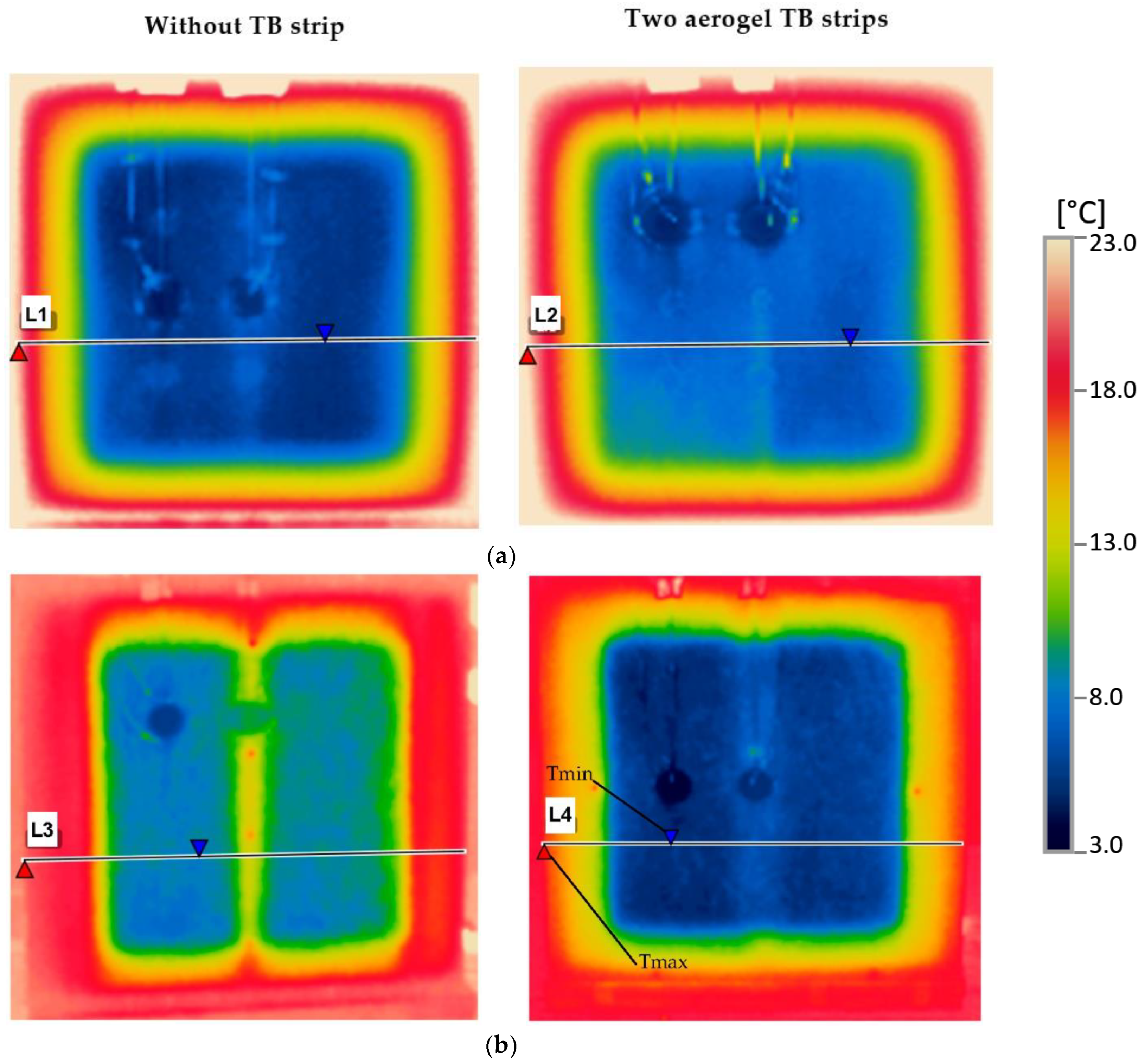
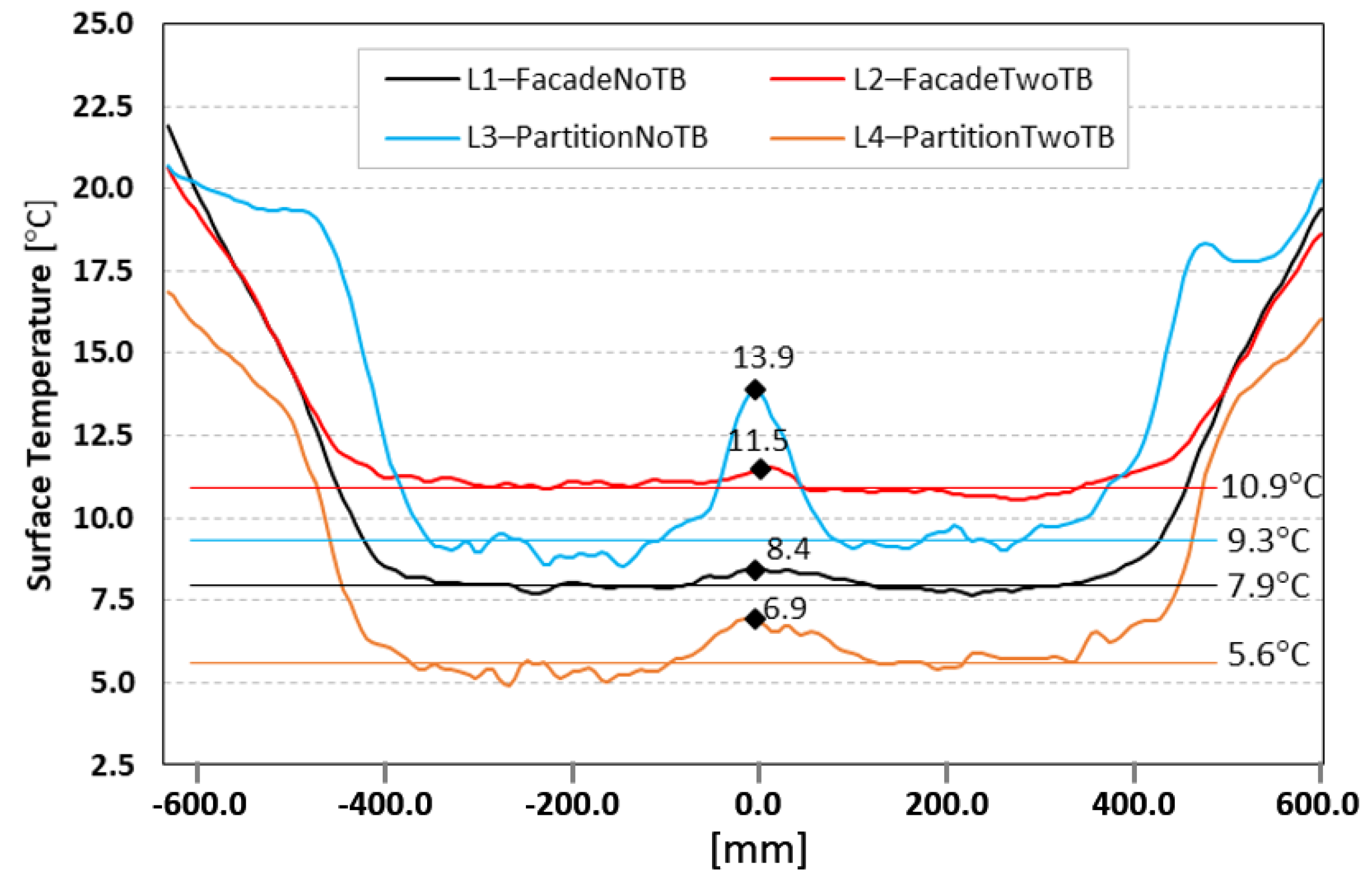
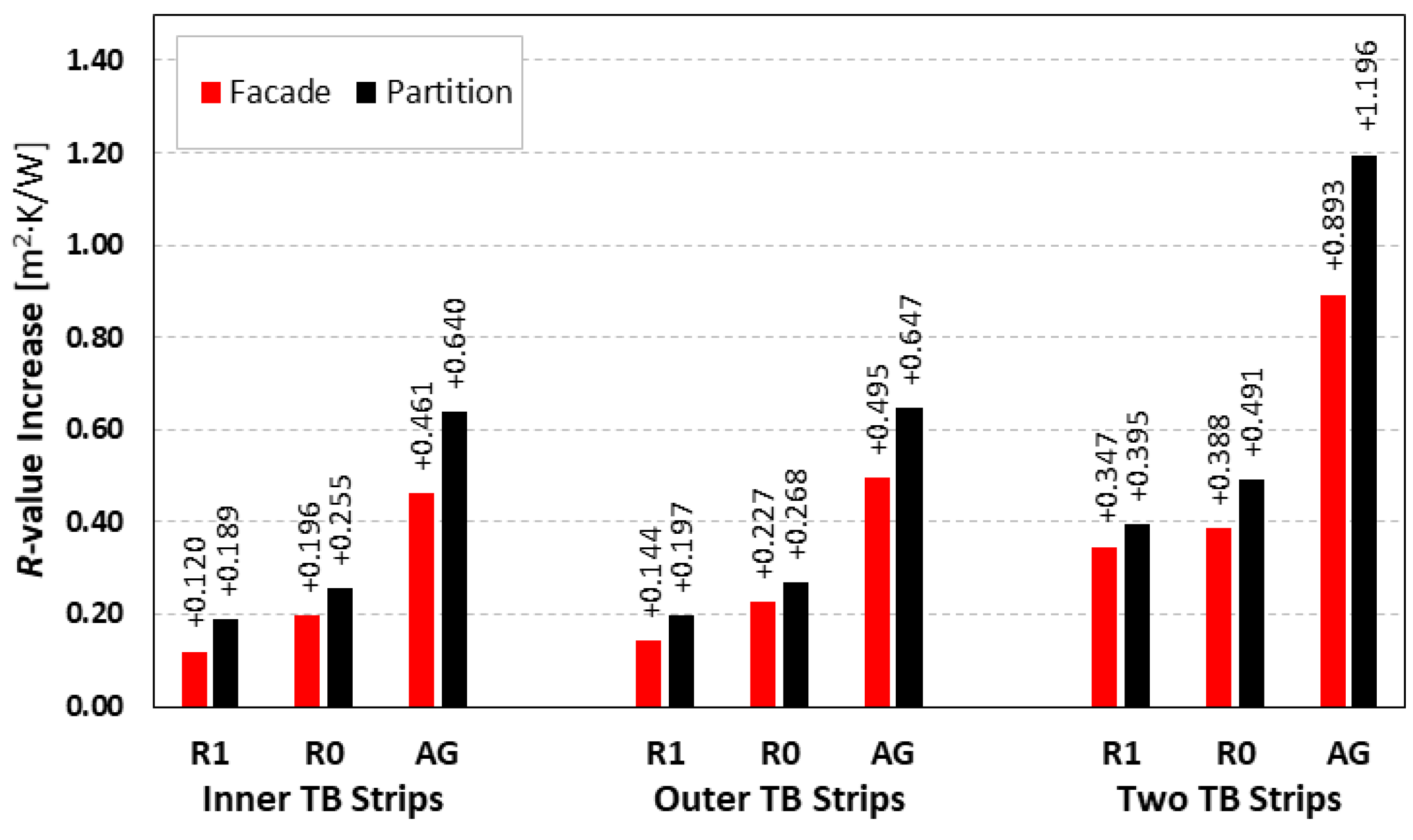
| Material (From Outer to Innermost Layer) | (mm) | (W/(m∙K)) | Ref. |
|---|---|---|---|
| ETICS 1 finishing layer | 5.0 | 0.450 | [31] |
| EPS 2 | 50.0 | 0.036 | [32] |
| OSB 3 | 12.0 | 0.100 | [33] |
| MW 4 | 90.0 | 0.035 | [33] |
| Steel profiles (C90 × 43 × 15 × 1.5 mm) | - | 50.000 | [34] |
| OSB 3 | 12.0 | 0.100 | [33] |
| GPB 5 | 12.5 | 0.175 | [33] |
| Global Thickness | 181.5 | - | - |
| Material | (W/(m∙K)) | Ref. |
|---|---|---|
| Recycled rubber (R1) | 0.122 | [33] |
| Recycled rubber and cork (R0) | 0.088 | [35] |
| CBS 1 aerogel (AG) | 0.015 | [33] |
| Wall Code | Wall Description | -Value (m2·K/W) | |
|---|---|---|---|
| THERM | Measured | ||
| Ref | Reference LSF Facade Wall | 3.200 | 3.200 |
| Difference: Absolute (m2∙K/W) and Percentage (%) | 0.000 | 0% | |
| R1in | Inner Recycled Rubber TB Strip | 3.404 | 3.320 |
| Difference: Absolute (m2∙K/W) and Percentage (%) | −0.084 | −2% | |
| R0in | Inner Rubber-Cork TB Strip | 3.441 | 3.396 |
| Difference: Absolute (m2∙K/W) and Percentage (%) | −0.045 | −1% | |
| AGin | Inner Aerogel TB Strip | 3.764 | 3.661 |
| Difference: Absolute (m2∙K/W) and Percentage (%) | −0.103 | −3% | |
| R1out | Outer Recycled Rubber TB Strip | 3.384 | 3.344 |
| Difference: Absolute (m2∙K/W) and Percentage (%) | −0.040 | −1% | |
| R0out | Outer Rubber-Cork TB Strip | 3.416 | 3.427 |
| Difference: Absolute (m2∙K/W) and Percentage (%) | 0.011 | 0% | |
| AGout | Outer Aerogel TB Strip | 3.707 | 3.695 |
| Difference: Absolute (m2∙K/W) and Percentage (%) | −0.012 | 0% | |
| R1 × 2 | Inner and Outer Recycled Rubber TB Strip | 3.587 | 3.547 |
| Difference: Absolute (m2∙K/W) and Percentage (%) | −0.040 | −1% | |
| R0 × 2 | Inner and Outer Rubber-Cork TB Strip | 3.658 | 3.588 |
| Difference: Absolute (m2∙K/W) and Percentage (%) | −0.070 | −2% | |
| AG × 2 | Inner and Outer Aerogel TB Strip | 4.224 | 4.093 |
| Difference: Absolute (m2∙K/W) and Percentage (%) | −0.131 | −3% | |
Publisher’s Note: MDPI stays neutral with regard to jurisdictional claims in published maps and institutional affiliations. |
© 2022 by the authors. Licensee MDPI, Basel, Switzerland. This article is an open access article distributed under the terms and conditions of the Creative Commons Attribution (CC BY) license (https://creativecommons.org/licenses/by/4.0/).
Share and Cite
Santos, P.; Mateus, D.; Ferrandez, D.; Verdu, A. Numerical Simulation and Experimental Validation of Thermal Break Strips’ Improvement in Facade LSF Walls. Energies 2022, 15, 8169. https://doi.org/10.3390/en15218169
Santos P, Mateus D, Ferrandez D, Verdu A. Numerical Simulation and Experimental Validation of Thermal Break Strips’ Improvement in Facade LSF Walls. Energies. 2022; 15(21):8169. https://doi.org/10.3390/en15218169
Chicago/Turabian StyleSantos, Paulo, Diogo Mateus, Daniel Ferrandez, and Amparo Verdu. 2022. "Numerical Simulation and Experimental Validation of Thermal Break Strips’ Improvement in Facade LSF Walls" Energies 15, no. 21: 8169. https://doi.org/10.3390/en15218169
APA StyleSantos, P., Mateus, D., Ferrandez, D., & Verdu, A. (2022). Numerical Simulation and Experimental Validation of Thermal Break Strips’ Improvement in Facade LSF Walls. Energies, 15(21), 8169. https://doi.org/10.3390/en15218169









